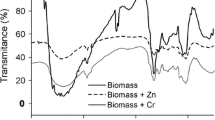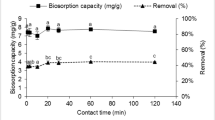Summary
Copper adsorption by Rhizopus arrhizus, Cladosporium resinae and Penicillium italicum was studied using a copper-selective electrode. Copper adsorption by C. resinae and P. italicum obeyed the Freundlich and Langmuir isotherms for single-layer adsorption whereas R. arrhizus followed the BET isotherm for multi-layer adsorption. Temperature had little effect on adsorption over the range 4–25°C. Mineral acids were effective for desorption of copper from preloaded biomass, the efficiency of desorption increasing with decreasing pH. Other cations were also capable of copper desorption with zinc showing the greatest efficiency and sodium the lowest.
Similar content being viewed by others
References
Adamson AW (1967) Physical chemistry of surfaces, 2nd edn, Interscience Publishers Inc, New York
Brierley JA, Brierley CL (1983) Biological accumulation of some heavy metals — biotechnological applications. In: Westbroek P, de Jong EW (eds) Biomineralization and biological metal accumulation. Reidel, Dordrecht, pp 499–509
Brunauer S, Emmett PH, Teller E (1938) Adsorption of gases in multimolecular layers. J Amer Chem Soc 60:309–319
Duddridge JE, Wainwright M (1980) Heavy metal accumulation by fungi and reduction in viability of Gammarus pulex fed Cd2+ contaminated mycelium. Wat Res 14:1605–1611
Freundlich H (1926) Colloid and capillary chemistry. Methuen, London
Gadd GM (1986) Fungal responses towards heavy metals. In: Herbert RA, Codd GA (eds) Microbes in extreme environments. Academic Press, London, pp 83–110
Gadd GM, Mowll JL (1985) Copper uptake by yeast-like cells, hyphae and chlamydospores of Aureobasidium pullulans. Exp Mycol 9:230–240
Galun M, Keller P, Feldstein H, Galun E, Siegel S, Siegel B (1983) Recovery of uranium (VI) from solution using fungi. II Release from uranium-loaded Penicillium biomass. Wat Air Soil Poll 20:277–283
Good NE, Winget GD, Winter W, Conolly TN, Izawa S, Singh RMM (1966) Hydrogen ion buffers for biological research. Biochemistry 5:467–477
Itoh M, Yuasa M, Kobayashi T (1975) Adsorption of metal ions on yeast cells at varied cell concentrations. Plant Cell Physiol 16:1167–1169
Langmuir I (1918) The adsorption of gases on plane surfaces of glass, mica, and platinum. J Amer Chem Soc 40:1361–1403
Mowll JL, Gadd GM (1983) Zinc uptake and toxicity in the yeasts Sporobolomyces roseus and Saccharomyces cerevisiae. J Gen Microbiol 129:3421–3425
Mowll JL, Gadd GM (1984) Cadmium uptake by Aureobasidium pullulans. J Gen Microbiol 130:279–284
Norris PR, Kelly DP (1977) Accumulation of cadmium and cobalt by Saccharomyces cerevisiae. J Gen Microbiol 99:317–324
Shumate SE, Strandberg GW (1985) Accumulation of metals by microbial cells. In: Moo-Young M (ed) Comprehensive Biotechnology, vol 4. Pergamon Press, New York, pp 235–247
Shumate SE, Strandberg GW, Parrott JR (1978) Biological removal of metal ions from aqueous process streams. Biotech Bioeng 8:13–20
Strandberg GW, Shumate SE, Parrott JR (1981) Microbial cells as biosorbents for heavy metals: accumulation of uranium by Saccharomyces cerevisiae and Pseudomonas aeruginosa. Appl Env Microbiol 41:237–245
Tobin JM, Copper DG, Neufeld RJ (1984) Uptake of metal ions by Rhizopus arrizus biomass. Appl Env Microbiol 47:821–824
Tsezos M (1983) The role of chitin in uranium adsorption by Rhizopus arrhizus. Biotech Bioeng 25:2025–2040
Tsezos M, Volesky B (1981) Biosorption of uranium and thorium. Biotech Bioeng 23:583–604
Weber WJ (1972) Adsorption. In: Weber WJ (ed) Physicochemical processes for water quality control. Wiley, New York, pp 199–259
Author information
Authors and Affiliations
Rights and permissions
About this article
Cite this article
de Rome, L., Gadd, G.M. Copper adsorption by Rhizopus arrhizus, Cladosporium resinae and Penicillium italicum . Appl Microbiol Biotechnol 26, 84–90 (1987). https://doi.org/10.1007/BF00282153
Received:
Revised:
Issue Date:
DOI: https://doi.org/10.1007/BF00282153




